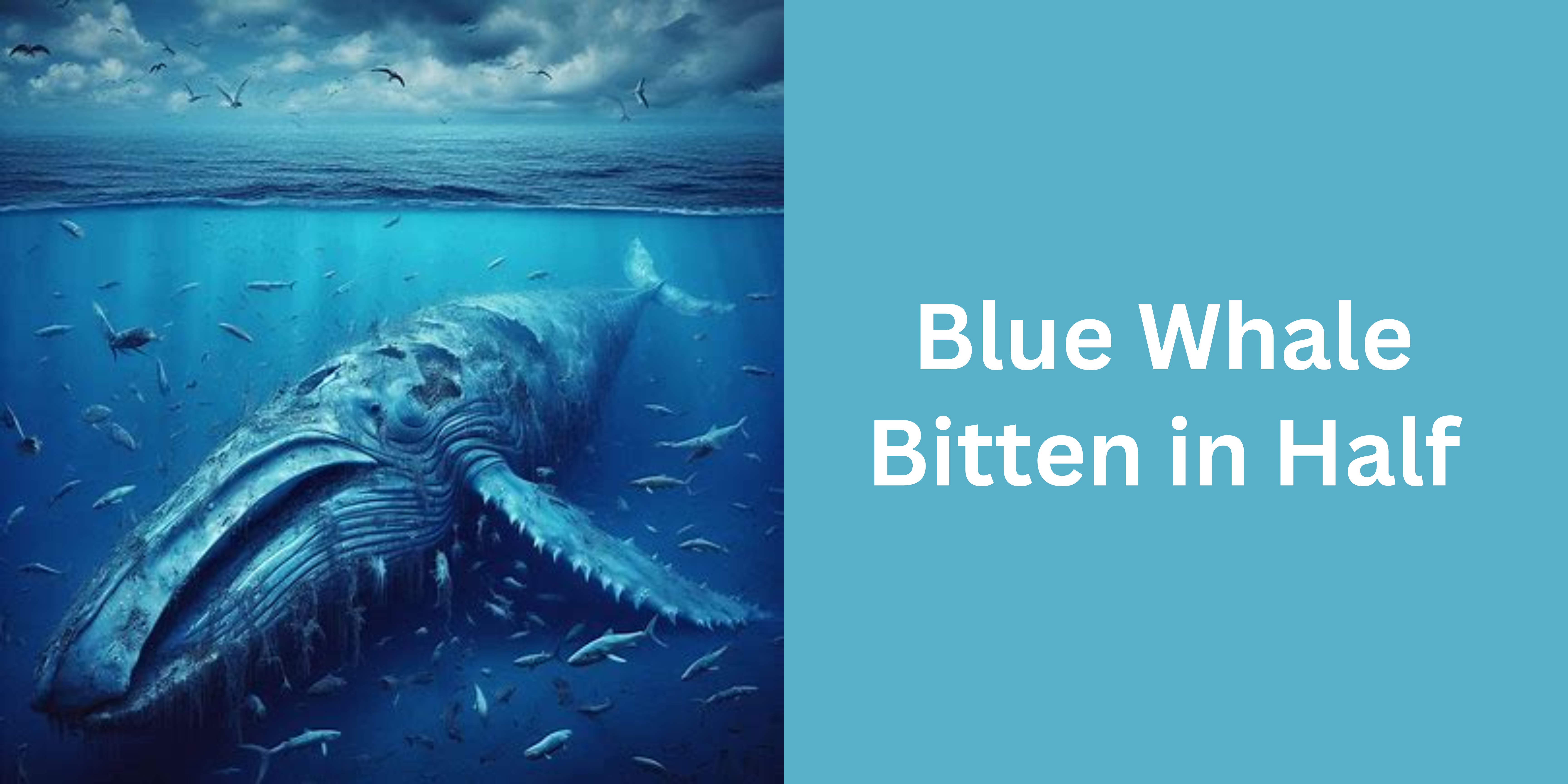Blue Whale Bitten in Half – The Truth Behind the Viral Incident
The internet has been buzzing with shocking claims about a blue whale bitten in half, with viral images and videos suggesting a terrifying attack by an unknown predator. This story has intrigued millions worldwide, sparking debates about whether a massive sea creature like a blue whale could actually be bitten in half.
In this article, we will separate fact from fiction, analyze the possible causes, explore scientific explanations, and debunk myths surrounding this viral claim. Let’s dive into the truth behind this mysterious ocean incident.
What Exactly Happened? The Origins of the Story
The claim about a blue whale bitten in half first emerged in 2021 when reports surfaced about a partially eaten whale carcass washing up on the coast of South Africa. Social media platforms like TikTok, Reddit, and YouTube fueled the speculation, with many suggesting that a massive shark or unknown sea monster was responsible.
However, upon closer inspection, marine experts and biologists noted that the whale carcass had likely been scavenged after death, rather than being attacked and bitten in half while alive.
Key Events Leading to the Viral Story:
| Year | Event | Details |
|---|---|---|
| 2021 | Viral Story Begins | Reports of a half-eaten whale appear on social media. |
| 2021 | Speculations Arise | People claim a massive predator attacked the whale. |
| 2022 | Fact-Checking Begins | Marine biologists investigate the incident. |
| 2023 | Myth Debunked | Experts confirm natural causes, not a giant sea creature attack. |
This timeline highlights how misinformation spreads quickly online, often leading to exaggerated claims.
Investigating the Claim: Can a Blue Whale Be Bitten in Half?
Could a Great White Shark Bite a Blue Whale in Half?
Many internet users speculated that a Great White Shark was responsible for the blue whale bitten in half. While Great White Sharks are powerful predators, their bite force (4,000 PSI) is not strong enough to slice a blue whale in half. Instead, they are known for attacking smaller prey like seals, sea lions, and dolphins.
Are Orcas (Killer Whales) the Real Culprits?
A more plausible explanation involves orcas, which are the only natural predators of blue whales. Killer whales have been observed hunting in packs and attacking even adult blue whales. However, orcas do not bite their prey in half; instead, they target the tongue, fins, and blubber-rich areas.
Could Natural Causes Explain the Damage?
Several natural phenomena could have led to a whale carcass appearing “bitten in half”, including:
- Decomposition: The body of a whale bloats and bursts as it decays, giving the illusion of a massive bite.
- Scavenger Activity: Sharks, seabirds, and smaller fish feed on dead whales, leading to irregular bite patterns.
- Boat Strikes: Large ships often collide with whales, causing severe injuries that resemble bite marks.
The Science of Whale Attacks: Predation vs. Scavenging
When large marine animals like blue whales die, their bodies sink or drift, making them vulnerable to scavengers. This is a common ecological process known as “whale fall,” where multiple species feed on the decaying remains over time.
Differences Between a Real Attack and Scavenging:
| Feature | Attack by Predator | Scavenging After Death |
|---|---|---|
| Bite Marks | Deep, targeted injuries | Random, uneven wounds |
| Damage Type | Focus on vital organs | Widespread small bites |
| Timeframe | Quick, violent attack | Gradual over weeks |
From this table, it’s clear that the blue whale bitten in half is more likely a result of post-mortem scavenging rather than a single attack.
How the Internet Helped Spread the Misinformation
The internet is a powerful tool, but it also plays a role in spreading misinformation. The blue whale bitten in half story gained traction through viral videos, manipulated images, and exaggerated headlines.
How Fake News Spreads Online:
- Shock Value: People are drawn to dramatic stories, making them more likely to share.
- Lack of Verification: Most people don’t fact-check before posting.
- Algorithm Boosts Sensational Content: Social media prioritizes viral posts, pushing misinformation further.
- Clickbait Culture: Many websites use exaggerated claims to gain more traffic.
To avoid being misled, it’s essential to verify sources and rely on expert analysis before believing such stories.
Blue Whale Conservation: The Real Threats
While the blue whale bitten in half story turned out to be a misconception, there are real issues that threaten the survival of blue whales.
Major Threats to Blue Whales:
- Climate Change: Affects their food supply and migration patterns.
- Ship Strikes: Large vessels often collide with whales, causing severe injuries.
- Pollution: Ocean contamination affects whale health and food sources.
- Illegal Whaling: Although banned, some countries still hunt whales.
How We Can Help:
- Support marine conservation efforts.
- Reduce plastic waste to prevent ocean pollution.
- Advocate for stronger marine protection laws.
By focusing on real-world whale conservation, we can help protect these magnificent creatures rather than getting distracted by internet hoaxes.
FAQs About the “Blue Whale Bitten in Half” Incident
Has there ever been a confirmed case of a sea creature biting a blue whale in half?
No, there are no confirmed scientific records of any marine predator biting a blue whale in half. Blue whales are the largest animals on Earth, and while they can be attacked by orcas or sharks, no single predator has been documented completely biting one in half. Most reported cases involve scavenging or post-mortem injuries.
Could an unknown deep-sea creature be responsible for such an attack?
While the ocean remains largely unexplored, there is no scientific evidence to support the existence of a creature capable of biting a blue whale in half. The idea of an undiscovered mega-predator is purely speculative and not backed by marine research. The largest known predators, like megalodon (which is extinct) or giant squid, do not have the ability to slice a blue whale in half.
How do marine biologists differentiate between a whale being bitten and natural decomposition?
Marine biologists use bite mark analysis, tissue examination, and carcass condition to determine whether injuries occurred before or after death. Decomposition, gas buildup, and bloating can cause a whale’s body to split, making it appear as if it were bitten in half. Experts also analyze tooth impressions, feeding patterns, and surrounding ecosystem activity to distinguish between natural scavenging and predation.
Why do people believe in exaggerated ocean myths like the “blue whale bitten in half”?
Many people are fascinated by mysteries of the deep ocean, and sensationalized stories often gain traction due to viral media, clickbait, and exaggerated headlines. Since most of the ocean remains unexplored, myths about giant sea monsters and unknown predators captivate public imagination, even when they lack scientific credibility.
What should you do if you come across misleading viral content online?
If you see a shocking claim, always fact-check the source before believing or sharing it. Use reliable websites like scientific journals, marine biology organizations, and government wildlife agencies to verify information. Look for expert opinions, reverse search images to check authenticity, and be skeptical of overly dramatic or unverified viral content.
Conclusion: Separating Fact from Fiction
The claim of a blue whale bitten in half is more fiction than fact. While a half-eaten whale carcass was discovered, there is no evidence to support that a single predator was responsible. Instead, factors like natural decay, scavenging, and ship strikes likely caused the damage.
By understanding marine biology and fact-checking viral stories, we can prevent misinformation from spreading. The real focus should be on whale conservation, ensuring these incredible animals thrive for future generations.
Would you like to learn more about blue whales, sharks, or other ocean mysteries? Stay updated with our latest articles and scientific insights!
Read more posts like
Complete Guide to the Nuvita Corsync Scale Manual
Online Food Trends Jalbiteblog: A Comprehensive Guide to Evolving Culinary Innovations
Rader Principal of Ruhl School: A Complete Guide to Leadership & Impact
The Ultimate Guide to Lovelolablog Codes: Unlock Exclusive Savings!
Software Name MeetShaxs: The Ultimate Guide to Business Collaboration






